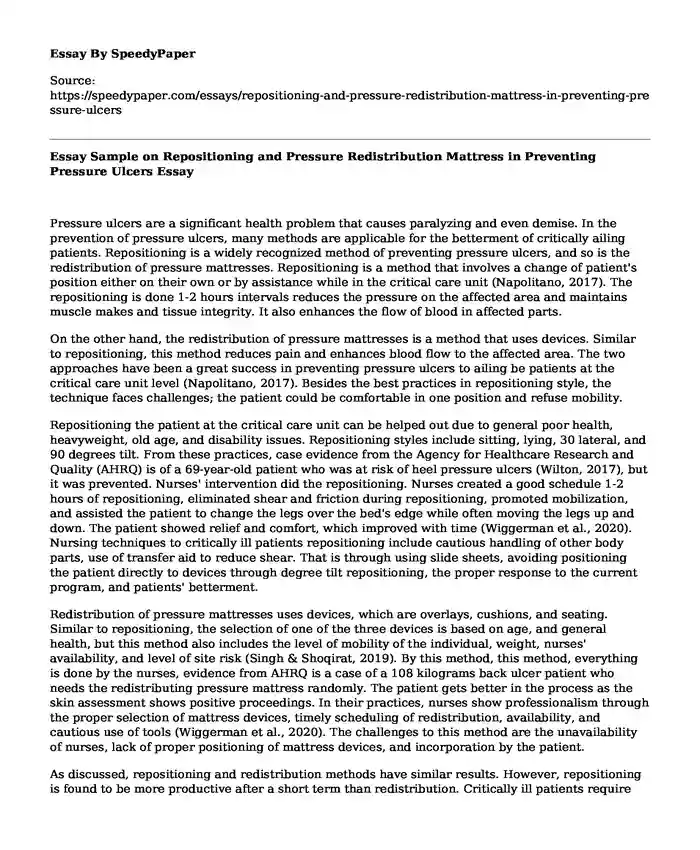
| Type of paper: | Research paper |
| Categories: | Healthcare Nursing care Human services |
| Pages: | 3 |
| Wordcount: | 653 words |
Pressure ulcers are a significant health problem that causes paralyzing and even demise. In the prevention of pressure ulcers, many methods are applicable for the betterment of critically ailing patients. Repositioning is a widely recognized method of preventing pressure ulcers, and so is the redistribution of pressure mattresses. Repositioning is a method that involves a change of patient's position either on their own or by assistance while in the critical care unit (Napolitano, 2017). The repositioning is done 1-2 hours intervals reduces the pressure on the affected area and maintains muscle makes and tissue integrity. It also enhances the flow of blood in affected parts.
On the other hand, the redistribution of pressure mattresses is a method that uses devices. Similar to repositioning, this method reduces pain and enhances blood flow to the affected area. The two approaches have been a great success in preventing pressure ulcers to ailing be patients at the critical care unit level (Napolitano, 2017). Besides the best practices in repositioning style, the technique faces challenges; the patient could be comfortable in one position and refuse mobility.
Repositioning the patient at the critical care unit can be helped out due to general poor health, heavyweight, old age, and disability issues. Repositioning styles include sitting, lying, 30 lateral, and 90 degrees tilt. From these practices, case evidence from the Agency for Healthcare Research and Quality (AHRQ) is of a 69-year-old patient who was at risk of heel pressure ulcers (Wilton, 2017), but it was prevented. Nurses' intervention did the repositioning. Nurses created a good schedule 1-2 hours of repositioning, eliminated shear and friction during repositioning, promoted mobilization, and assisted the patient to change the legs over the bed's edge while often moving the legs up and down. The patient showed relief and comfort, which improved with time (Wiggerman et al., 2020). Nursing techniques to critically ill patients repositioning include cautious handling of other body parts, use of transfer aid to reduce shear. That is through using slide sheets, avoiding positioning the patient directly to devices through degree tilt repositioning, the proper response to the current program, and patients' betterment.
Redistribution of pressure mattresses uses devices, which are overlays, cushions, and seating. Similar to repositioning, the selection of one of the three devices is based on age, and general health, but this method also includes the level of mobility of the individual, weight, nurses' availability, and level of site risk (Singh & Shoqirat, 2019). By this method, this method, everything is done by the nurses, evidence from AHRQ is a case of a 108 kilograms back ulcer patient who needs the redistributing pressure mattress randomly. The patient gets better in the process as the skin assessment shows positive proceedings. In their practices, nurses show professionalism through the proper selection of mattress devices, timely scheduling of redistribution, availability, and cautious use of tools (Wiggerman et al., 2020). The challenges to this method are the unavailability of nurses, lack of proper positioning of mattress devices, and incorporation by the patient.
As discussed, repositioning and redistribution methods have similar results. However, repositioning is found to be more productive after a short term than redistribution. Critically ill patients require the nurses' assistance. The level of ulcer prevention by these methods is very high, and once implemented, most patients tend to heal before pressure ulcers. The two approaches have shortcomings that can be solved by healthcare leaders by coming up with specific hitting strategies.
References
Austin & Jacobs. (2020). Two commonly used pressure redistributing mattresses are similar for preventing pressure ulcers but differ on price. doi: 10.3310/signal-000857
Napolitano, F. (2017). Technical Tools for Computational Drug Repositioning. Drug Repositioning, 83-104. doi: 10.4324/9781315373669-5
Singh, C. D., & Shoqirat, N. (2019). Pressure Redistribution Crib Mattress. Journal of Wound, Ostomy and Continence Nursing, 46(1), 62-64. doi: 10.1097/won.0000000000000500
Wiggermann, N., Zhou, J., & McGann, N. (2020). Effect of Repositioning Aids and Patient Weight on Biomechanical Stresses When Repositioning Patients in Bed. Human Factors, doi: 0018720819895850
Wilton. (2017). casts do not improve heel ulcers in diabetes. (2017). doi: 10.3310/signal-000479
Cite this page
Essay Sample on Repositioning and Pressure Redistribution Mattress in Preventing Pressure Ulcers. (2023, Apr 05). Retrieved from https://speedypaper.com/essays/repositioning-and-pressure-redistribution-mattress-in-preventing-pressure-ulcers
Request Removal
If you are the original author of this essay and no longer wish to have it published on the SpeedyPaper website, please click below to request its removal:
- Psychology Essay Example: Positivism and Conductivism
- Free Essay with Critical and Theological Film Reviews
- Intellectual Migration Among Kazakhstan Millennials. Paper Example
- Paper Example on Ethics and Policy
- Paper Example: Association of Critical Care Nurse
- Free Essay: Transitions of Care and the Prevention of Readmissions
- Free Essay Example. Nursing Profession Philosophy
Popular categories




